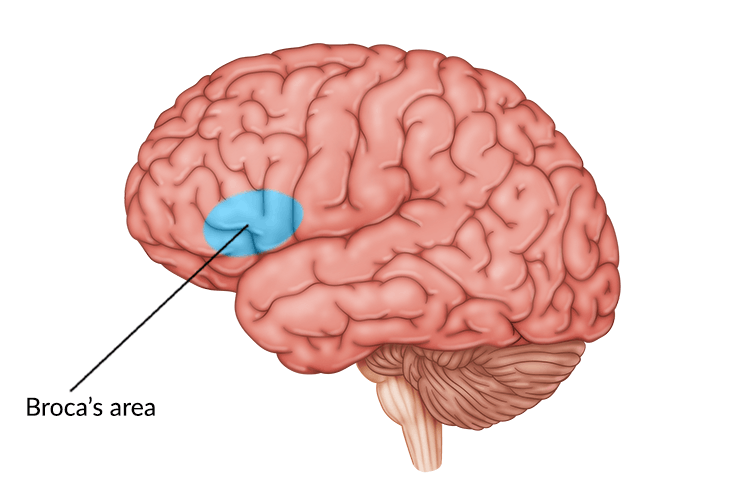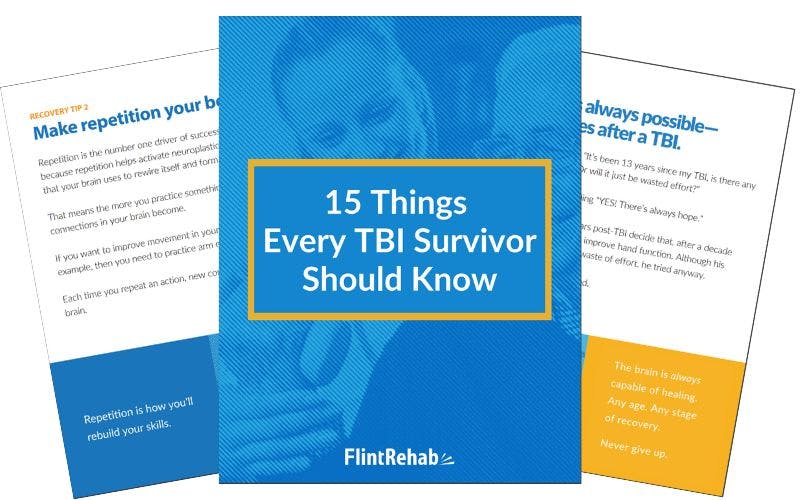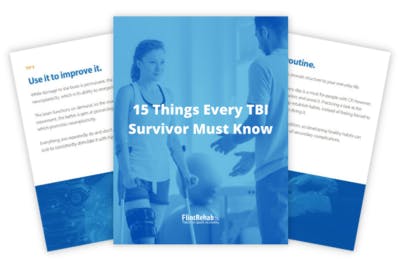Damage to Broca’s area, a small region located in the frontal lobe, can lead to a speech disorder known as Broca’s aphasia or expressive aphasia. Individuals with Broca’s aphasia have difficulty forming words and producing speech but do not struggle with comprehension.
The severity of aphasia depends on the severity of the injury to the brain, however most symptoms can be managed and improved through speech-language therapy.
This article will further discuss how damage to Broca’s area affects speech and language production and effective management techniques.
What Is Broca’s Area?
French scientist Pierre Paul Broca was among the first to provide evidence of the localization of brain function in the mid 1800’s. Pierre made these discoveries by observing and studying individuals who had left frontal lobe lesions. Through his rigorous studies, he discovered the area of the brain linked to speech and language, now famously known as Broca’s area.
This language-specific region is located in the frontal lobe of the dominant (usually left) hemisphere of the brain and is responsible primarily for planning the motions needed to produce speech. Broca’s area is particularly helpful in putting words together fluently to be able to form complete, complex, and coherent sentences.
Additionally, Pierre’s research has helped us obtain a better understanding of speech production, language processing, and comprehension of complex sentences, all of which can be affected by damage to Broca’s area.
Causes of Damage to Broca’s Area

Brain injuries involving the frontal lobe of the brain may result in damage to Broca’s area. While the frontal lobe is one of the most common areas of the brain affected by a TBI, every brain injury is different, and survivors may experience a variety of secondary effects depending on the location and severity of the injury.
There are many conditions that may result in damage to Broca’s area, including stroke, traumatic brain injury, tumors, and brain infections. The most common symptom of damage to Broca’s area is expressive (or non-fluent) aphasia. While there are many types of aphasia, expressive aphasia in particular is caused by damage to Broca’s area. Hence, it is also known as Broca’s aphasia.
Individuals with this speech disorder can typically understand what others are saying, but have difficulty finding their words and forming sentences verbally. For this reason, some incorrectly believe that aphasia is an issue with the muscles, throat, or mouth, rather than the result of damage to specific areas of the brain, such as Broca’s area. When the motor aspects or movements of speech production are affected, it is referred to apraxia of speech, while aphasia is an impairment of linguistic capabilities.
Symptoms of Broca’s Aphasia
Individuals with Broca’s aphasia may experience a variety of symptoms that can make it challenging to perform daily activities. The challenge with forming complete sentences especially can create feelings of frustration and impatience after a brain injury.
Often along with frustration, symptoms of Broca’s aphasia may include:
- Difficulty finding the appropriate word to speak
- Speaking in phrases limited to less than four words
- Irregular rhythm of speech
- Pausing excessively when attempting to speak
- Difficulty repeating what others said
- Trouble following directions
- Poor or absent grammar used
- Difficulty understanding complex sentences
- Mild reading impairment, especially when reading aloud
- Difficulty with writing
- In severe cases, mutism (inability to speak)
Additionally, some individuals may omit using certain pronouns and conjunctions such as “the,” “an,” or “is” in their sentences. For example, an individual with Broca’s aphasia may say “me, cup” rather than “I want the cup” when asking for something. Due to the location of Broca’s area, some individuals with Broca’s aphasia may also demonstrate weakness or paralysis on one side of their body (typically the right).
Diagnosing Expressive Aphasia
There are many types of aphasia that exist. In fact, it’s possible for individuals to have more than one type of aphasia simultaneously, and each may require a different treatment and rehabilitation plan.
While one of the most common types of aphasia after a brain injury is Broca’s aphasia, it’s important to obtain a proper diagnosis to ensure you receive the right treatment. A Speech-Language Pathologist (SLP) is often the best resource because they can make an assessment and provide you with an accurate diagnosis.
During your evaluation, a therapist will perform numerous exams that will test your reading, writing, and comprehension abilities. They may ask you to repeat phrases, write words, and name certain objects. As you perform these tasks, they will carefully examine your speech pattern and how you form your words. This will help them narrow down and identify which type of aphasia you have.
To identify the root cause of aphasia, a CT scan or brain MRI may be needed. This will help medical professionals see which areas of the brain were affected.
How Neuroplasticity Can Help Heal Damage to Broca’s Area
Injury to the brain can destroy connections within the brain called neural pathways. When this occurs, the brain cannot communicate properly with certain parts of the body, interfering with functions such as speech and language. Fortunately, the brain has the ability to heal and rewire itself through a phenomenon called neuroplasticity.
Neuroplasticity helps strengthen the existing neural pathways that were partially damaged and create new ones. To stimulate the brain and activate neuroplasticity, it’s crucial to practice high repetition of exercises, or massed practice.
Repeating a skill helps stimulate the brain and reinforce the neural pathways for that skill. Therefore, consistent practice is important to improve damage to Broca’s area and overcome expressive aphasia.
Speech-Language Therapy for Broca’s Aphasia

To achieve high repetition of exercises and activate neuroplasticity, survivors must engage in speech-language therapy for Broca’s aphasia. Speech-Language Pathologists can provide a variety of speech therapy activities that are suitable for your needs.
There are many types of therapies you can try depending on the severity of your aphasia. For example, for more severe cases such as those with mutism, your SLP may recommend trying Melodic Intonation Therapy (MIT) or singing therapy.
This type of therapy helps stimulate different areas of the brain such as the fronto-temporal regions of the right hemisphere, since music activates the more creative right side of the brain. This allows individuals to sing their words rather than speaking, which is a left hemisphere skill. MIT and singing therapy also help activate neuroplasticity and strengthen or create new neural pathways, which is necessary for improving function and promoting recovery.
Massed practice requires more than 1-2 therapy sessions a week; therefore it’s crucial to find ways to stay engaged and practice speech exercises daily. To help you stay focused and motivated in between your therapy sessions, you can try the CT Speech and Cognitive Therapy App. The app provides access to over 100,000+ speech and cognitive exercises you can practice from the comfort of your own home. The more you practice, the higher the chances of overcoming speech and language barriers after injury to the brain.
Damage to Broca’s Area Does Not Equal Loss of Intelligence

A brain injury can often feel like an invisible illness. Though a survivor may “look” fine, they may struggle with a combination of cognitive effects that are not physically apparent. It can be frustrating for individuals with Broca’s aphasia to try to express themselves but struggle to form the words. Therefore, it’s important for both the survivor and caregiver to have patience.
Note to Survivor: The aftermath of a brain injury can be challenging, but there is hope for recovery. If you struggle with Broca’s aphasia, you may respond slower than you normally did or may not be able to form a response just yet. However, it’s important to know that does not mean loss of intelligence. Aphasia affects the ability to communicate but not one’s intelligence. It may take some time but with consistent practice you can improve your speech abilities.
Note to Caregiver: When interacting with a survivor with Broca’s aphasia, speak to them the way you normally would. Individuals with expressive aphasia have no trouble with their hearing and typically have limited difficulties with comprehension. However, it may help to speak at a slower pace and use simpler words if they seem to struggle with understanding you. It’s important not to raise your voice or ask complicated questions. Allow them time and space to form their words and help them express themselves as much as you can.
Though the brain is healing it requires time, consistent practice, and patience. Encourage survivors to find their own pace and keep going.
Understanding Damage to Broca’s Area
Damage to Broca’s area can occur from a variety of neurological conditions including traumatic brain injury. This can result in a speech and language disorder known as expressive aphasia, or Broca’s aphasia. Individuals with Broca’s aphasia can comprehend words but struggle to form them.
Fortunately, with therapy survivors can improve their speech abilities. Speech therapy exercises help stimulate the brain and activate neuroplasticity, therefore staying focused and engaged is crucial. To boost your motivation, you can try the Speech and Cognitive Therapy App and improve your speech abilities from anywhere.
We hope this article helped you understand damage to Broca’s area and how the rehabilitation process works.














